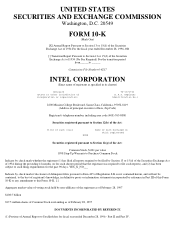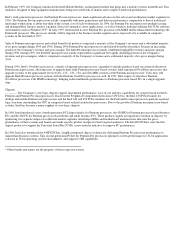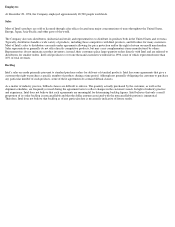Intel 1996 Annual Report Download - page 9
Download and view the complete annual report
Please find page 9 of the 1996 Intel annual report below. You can navigate through the pages in the report by either clicking on the pages listed below, or by using the keyword search tool below to find specific information within the annual report.Competition
The Company competes in different product lines to various degrees on the basis of price, performance, availability and quality. Intel is
engaged in a rapidly advancing field of technology in which its ability to compete depends upon the continuing improvement of its products
and processes, continuing cost reductions and the development of new products to meet changing customer requirements. Prices decline rapidly
in the semiconductor industry as unit volume grows, as competition develops, and as production experience is accumulated. Many companies
compete with Intel and are engaged in the same basic fields of activity, including research and development. Both foreign and domestic, these
competitors range in size from large multinationals to smaller companies competing in specialized market segments. In microprocessor board-
level and system products, Intel competes with board manufacturers and microprocessor-based computer manufacturers. Some competitors are
also Intel customers.
A number of competitors have developed and begun marketing products that are software compatible with some of the Company's key
products. In particular, companies have announced plans to ship products in 1997 intended to compete with the Pentium and Pentium Pro
microprocessor families. Many of Intel's competitors are licensed to use Intel patents. Furthermore, based on the current case law, Intel's
competitors can design microprocessors that are compatible with Intel microprocessors and avoid Intel patent rights through the use of foundry
services that have licenses with Intel. Competitors' products may add features, increase performance or sell at lower prices. The Company also
faces significant competition from companies that offer rival microprocessor architectures. The Company cannot predict whether such rival
architectures will establish or increase market acceptance or provide increased competition to the Company's products. Future distortion of
price maturity curves could occur as software compatible products enter the market in significant volume or alternative architectures gain
market acceptance.
Intel's strategy has been, and continues to be, to introduce ever higher performance microprocessors. To implement this strategy, the Company
plans to cultivate new businesses and continue to work with the software industry to develop compelling applications that can take advantage
of this higher performance, thus driving demand toward the newer products. Intel also is committed to the protection of its intellectual property
rights against illegal use. There can be no assurance, however, that competitors will not introduce new products (either software compatible or
of rival architectural designs) or reduce prices on existing products. Such developments could have an adverse effect on Intel's revenues and
margins.
Research and Development
The Company's competitive position has developed to a large extent because of its emphasis on research and development. This emphasis has
enabled Intel to deliver many products before they have become available from competitors, and thus has permitted Intel's customers to commit
to the use of these new products in the development of their own products. Intel's research and development activities are directed toward
developing new products, hardware technologies and processes, and improving existing products and lowering their cost. Intel is jointly
developing a new 64-bit microprocessor architecture and software optimizations with a third party. New 64-bit processors based on this
architecture are expected to be initially targeted at server, workstation and enterprise computing products, probably in the late 1990s. The
Company also develops "enabling" software technologies, such as open software specifications and software tools, to enhance the functionality
and acceptance of the personal computer platform. Intel's expenditures for research and development were $1,808 million, $1,296 million and
$1,111 million in fiscal years 1996, 1995 and 1994, respectively. As of December 28, 1996, Intel had approximately 9,100 employees engaged
in research and development. The results of Intel's research and development activities depend upon competitive circumstances and Intel's
ability to transfer new products to production in a timely and cost-effective manner.
Most design and development of components and other products is performed at Intel's facilities in Santa Clara and Folsom, California; Aloha
and Hillsboro, Oregon; Chandler, Arizona; and Haifa, Israel.






















